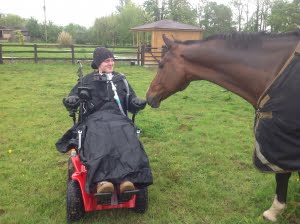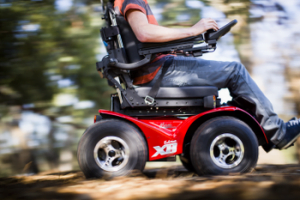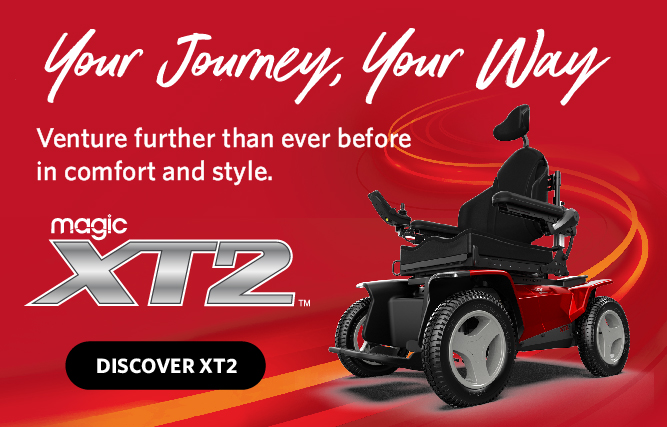Staying Safe
Service & Support
Staying Safe
Using your Magic Mobility power wheelchair safely also depends upon your own good judgement and common sense, as well as that of your provider, caregiver, or health professional. We cannot be responsible for injuries or damage resulting from any person’s failure to follow the warnings, cautions and instructions given in your Owner’s Manual.
We’ve listed out the times when your safety is most at risk, and we would encourage you to consider these closely.
Transfers
To reduce the chance of injury, it’s recommended that you have a trained attendant present while you learn to transfer.
All transfers
- Be sure the power is turned off to prevent unexpected powerchair movement
- Make sure motor brakes are engaged and the powerchair is not in freewheel
- Ensure footrests are swung away, flipped up or removed
- Don’t stand on footplates when you transfer as it may cause the powerchair to tip
- Make sure your feed do not “hang up” or get caught in the space between the footplates
- Drive straight for a short distance to ensure castor wheels are positioned to avoid tripping
- Ensure armrest do not interfere with transferring
- When transferring, try to avoid putting all your weight on one armrest. This may cause the powerchair to tip and cause injury.
Side transfers
- To side transfer, ensure armrests and legrests are swung away or removed. Position yourself as far back as possible in the powerchair seat to prevent it from tipping forward. Move your chair as close as you can to the seat you are transferring to. If possible, use a transfer board
- Transfer as far back onto the seat surface as you can. This will reduce the risk that you will miss the seat or fall.
Stairs and escalators
Your power wheelchair is not designed to negotiate stairs. Please refer to the Powerchair Owner’s Manual for more information.
Public roadways
You should not operate your power wheelchair on public streets and roadways. This is in accordance with local traffic laws, which vary by country. Please check your local traffic laws.
Tackling obstacles
- Proceed with extreme caution when driving near raised surfaces, unprotected ledges, drop-offs, kerbs, porches, stairs, escalators, lifts, etc. Always approach an obstacle so both front wheels touch that obstacle together. Never attempt to climb a kerb or obstacle at an angle.
- Don’t attempt to ascend any kerb near a drain cover, uneven surfaces or gravel covering.
- Avoid travelling backwards down any step, kerb, or other obstacle.
Positioning belts
It’s the purchaser, therapist and healthcare professionals obligation to determine if a positioning belt is required to ensure user’s safe operation of the powerchair. Positioning belts can be ordered through your Magic Mobility agent.

Tackling corners
Excessively high cornering speeds can cause your powerchair to tip over. If you feel that you may tip over when cornering, immediately reduce your speed and decrease the sharpness of the turn.
These tips may help reduce the risk of accidents:
- Reduce cornering speed
- Reduce turn sharpness
- Be aware of uneven, rough and slippery terrain
- Avoid turning on sloped surfaces
- Be aware of changing surfaces – such as passing from a paved area to a gravel area at high speed while turning
- Avoid abrupt directional changes.

Critical water safety and cleaning
Your wheelchair has electric motors so must never be driven through water, rivers, streams and the sea. Any damage that occurs from driving in water can void your warranty.
When your power wheelchair has been used in coastal, wet or salty environments, extra cleaning care is critical to reduce the risk of rust. After returning from your drive all powerchair parts should be wiped down with a warm water cloth.
The powerchair should then be left in a warm and dry environment to dry thoroughly. It may also help to blow as much sand and/or salt off as possible. Never, ever hose down your powerchair.
Crash testing, tie downs and seat belts
Magic Mobility powerchairs comply with the requirements of ISO7176-19 and, as such have been designed and tested for use only as a forward facing seat in motor vehicles. The powerchair has not been tested in other positions.
Testing has been conducted with a representative four-point strap system (two at the front and two at the rear). Use only with powerchair tie down and occupant restraint systems suitable for the powerchair weight including options that have been installed in accordance with the manufacturer’s instructions. The restraint system must conform to SAE J2249 (USA) or ISO10542 (International).
- Powerchairs secured in a vehicle don’t provide the same safety and security as vehicle seating. Magic Mobility recommends that users transfer to the vehicle seat and use the vehicle-installed restraint system whenever possible. The unoccupied powerchair should then be stored as cargo or secured in the vehicle.
When seat positioning options are fitted the following should be followed whenever feasible.
Seat elevator – fully DOWN with the seat at its lowest level
Seat tilt – fully DOWN with the seat parallel to the ground
Legrest – fully DOWN with feet close to the floor and knees bent to 90°
Backrest – upright, at or as close to 90° to the seat.
Please refer to the Owner’s Manual for further instructions relating to the securing powerchairs in the vehicle or cargo areas and also for more information relating to the strap restraint system, occupant restraint instructions and positioning the occupant restraint.
Tests were conducted with a 102kg crash test dummy. Occupants with a higher weight are at increased risk during an accident.
Magic Mobility recognises that it is not always practical for users to be transferred. In this circumstance, where the user must be transported while in the powerchair, the following advice must be followed:
- User safety during transportation depends upon the diligence of the person securing the tie down restraints. They should have received appropriate instructions and/or training in their use
- Attach occupant restraints according to manufacturer’s instructions and SAE J2249
- Don’t use WTORS designed to rely on the powerchair structure to transfer occupant restraint loads to the vehicle
- Magic Mobility powerchairs comply with the requirements of the ISO 7176-19 and, as such, have been designed and tested for use only as a forward-facing seat in a motor vehicle.
- Note – compliance to this standard does not preclude using the powerchair rearward in large accessible vehicles equipped with rear facing passenger stations
- The powerchair has been dynamically tested in a forward-facing orientation with the crash test dummy restrained by both pelvic and shoulder belts (eg. a shoulder belt as part of a three-point belt restraint)
- Both pelvic and shoulder belt restraints should be used to reduce the possibility of head and chest impacts with vehicle components.
- To reduce the potential of injury to vehicle occupants, powerchair mounted trays not specifically designed for crash safety should:
- be removed and secured separately in the vehicle, or
- be secured to the powerchair but positioned away from the occupant with energy absorbing padding placed between the tray and the occupant
- When possible, other auxiliary powerchair equipment should either be secured to the powerchair or removed and secured in the vehicle during travel. This will ensure that it doesn’t break free and cause injury to vehicle occupants in the event of a collision
- Postural supports should not be relied upon for occupant restraint in a moving vehicle, unless they are labelled in accordance with the requirements specified in ISO7176-19
- The powerchair should be inspected by a manufacturer’s representative before reuse following involvement in any type of vehicle collision
- Alterations or substitutions should not be made to the powerchair securement points or to structural and frame parts or components without consulting the powerchair manufacturer
- Spill proof sealed batteries such as “gelled electrolyte” should be installed on powerchairs when used in a motor vehicle
- Care should be taken when fixing the occupant restraint to position the seat buckle. This will ensure that the release button is not contacted by powerchair components during a crash.
Sign up to our Newsletter
Stay up to date with our latest innovations and user stories.
Cookies & Privacy
This website uses cookies to ensure you get best experience on our website.
 Magic Mobility
Magic Mobility



